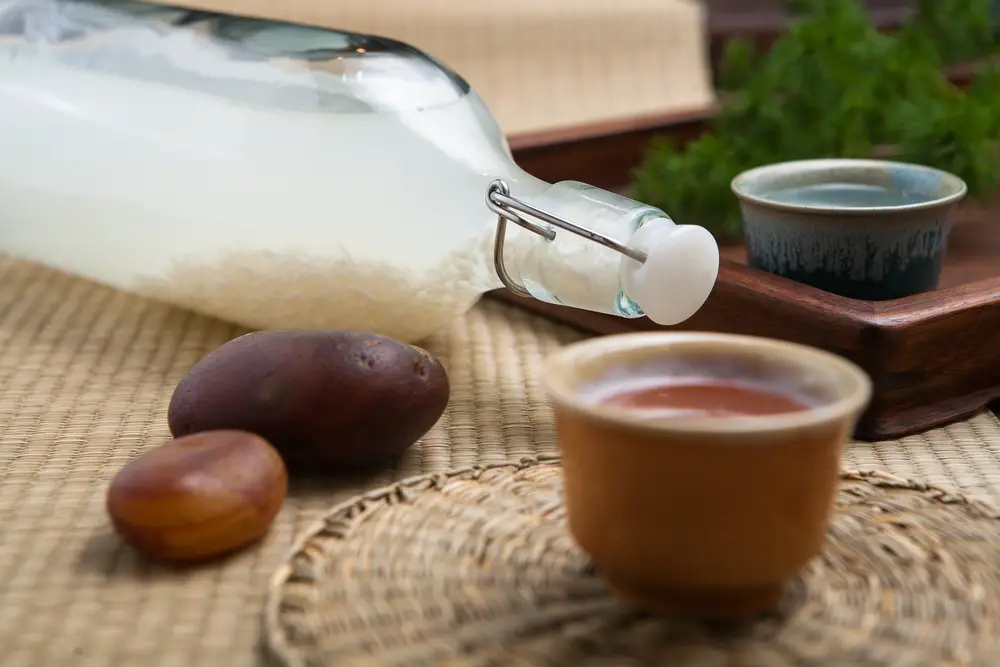Rice wine is fermented and distilled from rice and is traditionally consumed in East Asia, Southeast Asia, and Northeast India. Rice wines are consumed as a beverage but are also used in cooking recipes throughout Asia.
Rice wine can be savory or sweet, enjoyed on its own, or incorporated into recipes for an enhanced flavor. It can also be drizzled over a bowl of fresh fruit, frozen into a sorbet, or used as a marinade for steamed fish or chicken.
If you’re hoping to make rice wine at home, the good news is it requires only two ingredients. The downside is that it does take time to ferment. However, the end result is super versatile and in our opinion, is worth the wait.
You’ll need:
- 2 cups (24 ounces) sticky or glutinous rice
- 1 wine yeast ball (also called qu, jiuqu, or chiuyao in Mandarin)
Recipe: how to make rice wine
Part 1: cooking the rice
- You’ll first need to measure out 2 cups (24 ounces) of rice in a measuring cup, and then rinse the rice several times in a large bowl until the water runs clear. It may not be completely clear, but just ensure it’s not as murky as before.
- It’s best to use a glutinous or sticky variety of rice rather than regular white rice.
- After rinsing, soak your rice in hot water for about an hour, as this will better prepare the rice for cooking. Then use a strainer or sieve to strain the rice.
- Fill the bottom of a steamer with 2 cups of water (or alternatively, boil water in a medium-sized pot), then bring the water to a boil.
- Once the water begins to boil, place the rice in the top compartment of the steamer and allow it to steam for approximately 25 minutes.
- If you’re using the pot method as you don’t have a steamer, you can place the sieve of rice above the boiling water, ensuring the rice doesn’t touch the water. Cover the top of the sieve with a pot lid and let the rice steam for 25 minutes.
- After 25 minutes, taste the rice to check if it’s cooked. If it’s still slightly crunchy, use a spoon to flip the rice over and let it steam for longer, checking every five minutes or so to see if it’s cooked through. Once you’re satisfied with the consistency, remove the rice from the heat.
- Spoon the freshly steamed rice onto a cooking sheet, spreading it in a thin layer. You’ll need to allow the rice to cool fully before beginning the fermentation process, and spreading the rice in this manner helps it to lose heat more rapidly.
Part 2: fermenting the rice
- Take the yeast ball and place it in a small bowl, then use a pestle or the bottom of a large spoon to crush the yeast ball into a fine powder.
- After crushing the yeast, sprinkle the powder evenly over the rice. Use your hands or a spoon to toss the rice and combine it with the yeast. Before fermentation, ensure the rice has cooled so that it’s just slightly warmer than room temperature.
- Once the yeast and rice are combined, you should start the process of storing and fermenting the rice. Place the rice in an airtight container, or divide it into several smaller containers if required.
- You should try to keep the rice in a warm place for a few days, as the heat helps to encourage fermentation. Keep the container of rice in the oven on low heat (100 degrees F or 37.7 degrees C), or a simpler option is to place a heating pad around the jar.
- If placing your container in the oven – ensure that it’s oven-safe.
Part 3: testing and straining the rice wine
- After a few days, the liquid should start to accumulate at the bottom of the container – this is your rice wine! It’s ready to drink as soon as it forms, so you can try the wine straight away.
- If you like the taste, pour out the liquid from the container, keeping the rice mixture inside. You can use this small amount in recipes, or simply enjoy the wine by itself.
- The longer the wine ferments, the more the taste will change. At first, the wine will taste sharp and fruity, but the longer it ferments, the sweeter and smoother it’ll become.
- For the best results, allow the wine to ferment for at least a month, storing it in a warm or dry place. This doesn’t have to be in the oven or inside a heating pad, just find a relatively warm place in your house.
- The longer the wine is left to ferment, the clearer the liquid will become.
- After a month, the fermentation process will be complete, and it’s time to strain your wine. Use a piece of cheesecloth or a very fine strainer to strain the liquid into a jar or container.
- Straining the wine gets rid of any excess rice grains or hulls still lurking in the container. Ensure the top of the container is sealed.
- Enjoy your wine straight away if you wish, or place the container of rice wine in the refrigerator. You can drink rice wine at room temperature, but you should always store it in the fridge, as this will help prolong its shelf life.
Part 4: drinking and enjoying the rice wine
- A few days after you put the wine in the refrigerator, a layer of sediment will start to form at the bottom of the container. There’s no need to remove this sediment, but some people do so to improve the appearance of the wine and make the texture smoother.
- You can use your wine in cooking or enjoy it by itself. Keeping the wine refrigerated will allow the flavor to mature, so don’t worry if you see the wine darkening in color – this is normal.
- The rice wine can be used in both sweet or savory dishes or enjoyed as an alternative to regular grape-based wine.










